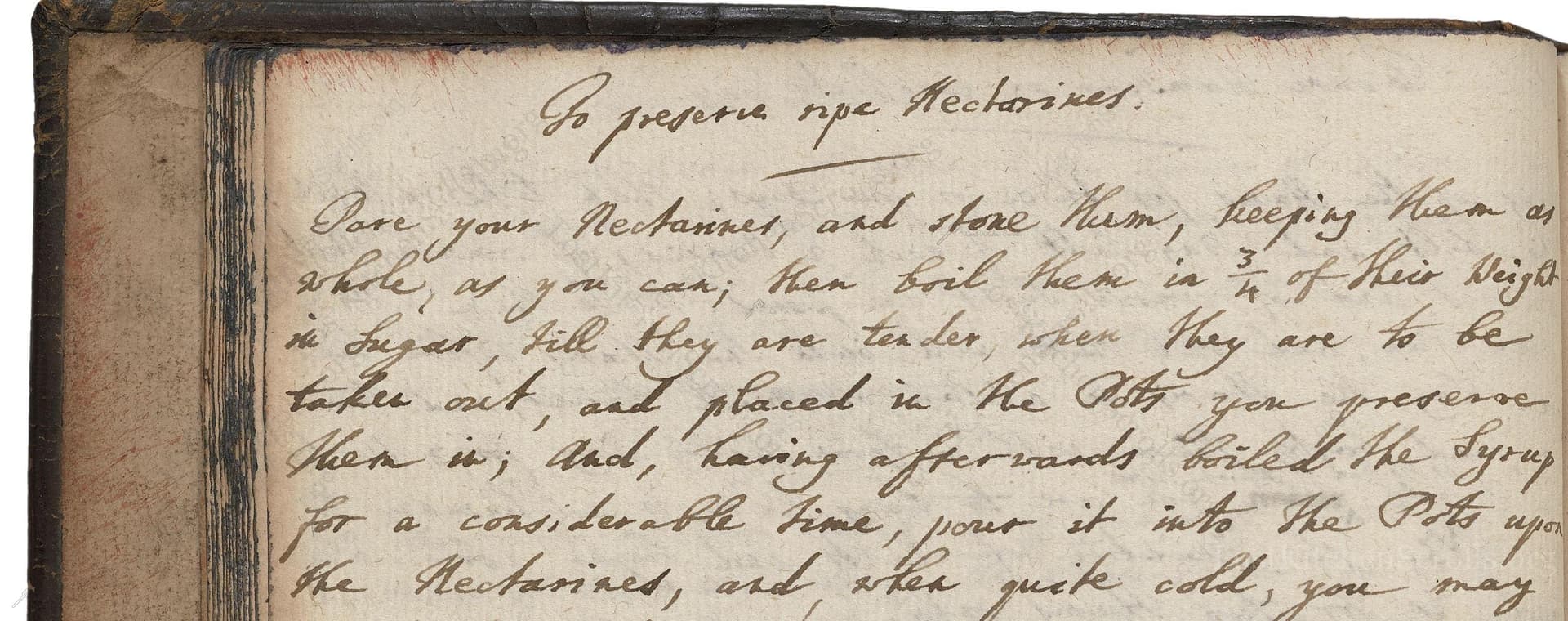To Preserve Ripe Nectarines
From the treasured pages of Medicinal recipes compiled by Andrew Slee
Written by Andrew Slee

To Preserve Ripe Nectarines
"Pave your Nectarines whole, as you can; Then boil them in ³⁄₄ of their weight in Sugar, till they are tender, when they are to be taken out, and placed in the Pots you preserve Them in; And, having afterwards boiled the Syrup for a considerable time, pour it into the Pots upon the Nectarines, and, when quite cold, you may paper Them down."
Note on the Original Text
Recipes from this era are concise and assume considerable prior kitchen knowledge. Quantities are often given in proportions rather than fixed measures, here using fractions of weight (³⁄₄). Instructions are minimal and rely on intuition—for instance, 'tender' is the cue for doneness, and 'paper them down' refers to sealing the surface with oiled or waxed paper. Spelling and capitalization are inconsistent, reflecting the manuscript culture and transitional English orthography of the seventeenth century.

Title
Medicinal recipes compiled by Andrew Slee (1654)
You can also click the book image above to peruse the original tome
Writer
Andrew Slee
Era
1654
Publisher
Unknown
Background
A delectable glimpse into 17th-century kitchens, this manuscript compiled by Andrew Slee promises an array of historical recipes and culinary secrets sure to delight any gourmand with a taste for the past.
Kindly made available by
Folger Shakespeare Library
This recipe comes from mid-17th century England, a time when sugar had become more accessible but was still prized. Preserving fruit whole in syrup was a luxury and a means of prolonging the enjoyment of summertime bounty. Andrew Slee, listed as compiler in 1654, reflects household manuscript culture—where recipes were shared, recorded, and often adapted from mouth to mouth and house to house. This kind of preserve would have graced the table of those who could afford such sweet delicacies, especially out of season.

Back in 1654, nectarines would have been preserved over an open hearth or a coal-fired kitchen range in a heavy brass, copper, or earthenware pot. Weighing was done with balance scales and simple weights. Jars or pottery crocks were used for storage, with parchment paper or leather tied down as a lid, often secured with string or wax to keep out air.
Prep Time
10 mins
Cook Time
45 mins
Servings
8
We've done our best to adapt this historical recipe for modern kitchens, but some details may still need refinement. We warmly welcome feedback from fellow cooks and culinary historians — your insights support the entire community!
Ingredients
- 2.2 pounds ripe nectarines (whole, unpeeled)
- 1.65 pounds granulated sugar
Instructions
- Begin by choosing whole, ripe nectarines and gently wash them.
- Leave the nectarines unpeeled and whole.
- Weigh the nectarines, then measure out sugar equal to three-quarters of their weight.
- For instance, for every 2.2 pounds of nectarines, use 1.65 pounds of sugar.
- Place the nectarines and sugar in a large saucepan.
- Bring to a gentle simmer over medium-low heat and cook, occasionally stirring, until the nectarines are tender but still hold their shape—this should take about 20-30 minutes.
- Use a slotted spoon to carefully remove the nectarines and place them into clean, sterilized preserving jars.
- Continue to boil the remaining syrup in the pan for another 10-15 minutes, or until it has thickened and reduced slightly.
- Pour the hot syrup over the nectarines in the jars, ensuring the fruit is completely covered.
- Allow the jars to cool completely before sealing with parchment paper under the lid (or modern lids if preferred).
- Store in a cool, dark place.
Estimated Calories
200 per serving
Cooking Estimates
You will need about 10 minutes to wash and weigh the nectarines and measure the sugar. The cooking process takes around 35 to 45 minutes in total, including simmering the fruit and reducing the syrup. Each serving has about 200 calories, and this recipe makes 8 servings.
As noted above, we have made our best effort to translate and adapt this historical recipe for modern kitchens, taking into account ingredients nowadays, cooking techniques, measurements, and so on. However, historical recipes often contain assumptions that require interpretation.
We'd love for anyone to help improve these adaptations. Community contributions are highly welcome. If you have suggestions, corrections, or cooking tips based on your experience with this recipe, please share them below.
Join the Discussion
Rate This Recipe
Dietary Preference
Main Ingredients
Culinary Technique

Den Bockfisch In Einer Fleisch Suppen Zu Kochen
This recipe hails from a German manuscript cookbook compiled in 1696, a time whe...

Die Grieß Nudlen Zumachen
This recipe comes from a rather mysterious manuscript cookbook, penned anonymous...

Ein Boudain
This recipe comes from an anonymous German-language manuscript cookbook from 169...

Ein Gesaltzen Citroni
This recipe, dating from 1696, comes from an extensive anonymous German cookbook...
Browse our complete collection of time-honored recipes



